Alexander Calder – Introducing the Kinetic Mobile Artist
American artist Alexander Calder was an innovative artist whose imaginative and kinetic sculptures greatly influenced 20th-century art. Throughout his lengthy career, Calder formed wire and metal into dynamic sculptures that pushed the boundaries of conventional art. This article explores the life and artistic work of Alexander Calder, emphasizing his significant impact on contemporary art.
Contents
Artist in Context: Who Is Alexander Calder?
| Date of Birth | 22 July 1898 |
| Date of Death | 11 November 1976 |
| Country of Birth | Lawnton, Pennsylvania, United States |
| Art Movements | Surrealism and kinetic art |
| Mediums Used | Sculpture and painting |
American sculptor Alexander Calder, also known as “Sandy”, was born in Pennsylvania. He came from a family of artists, including his mother and grandfather who were also successful artists, and his father, the well-known sculptor Alexander Stirling Calder. The mobile, a form of kinetic art that requires meticulous balance and suspension, and wire sculptures, are among Calder’s most inventive creations.

Childhood
Alexander Calder, born in 1898, had an unusual upbringing as the second child of two successful artist parents. His mother painted, and his father, Alexander Stirling Calder, was a sculptor. Because his father was involved in commissions for public art, Alexander’s early years were spent traveling the nation with the Calder family. Calder’s artistic abilities were encouraged from an early age, and by the time he was eight years old, he had his own workshop wherever the family lived. In 1909, when Calder was eleven years old, he made two of his earliest sculptures—a small brass dog and a duck that were expertly formed from brass sheet—and gave them to his parents as a Christmas present.
The duck was especially kinetic; it rocked back and forth in response to gentle pressure, demonstrating his early material handling skills.
Early Training
Despite his artistic aptitude, Calder first followed a different route after graduating from high school, persuaded by a friend’s recommendation, and he enrolled at the Stevens Institute of Technology. But soon after receiving his degree in 1919, he returned to the artistic roots of his family. Notably, he later denied that his engineering coursework at Stevens had any real bearing on the creation of his renowned mobiles. He took the crucial choice to fully commit to the art world in 1923. He did this by enrolling in courses at the Art Students League in New York, where he studied under eminent teachers like Boardman Robinson and John Sloan. In addition to his studies, Calder illustrated for the National Police Gazette, which led to an interesting assignment in 1925. After being dispatched to the Ringling Bros. and Barnum & Bailey Circus, he spent two weeks drawing various circus scenes.
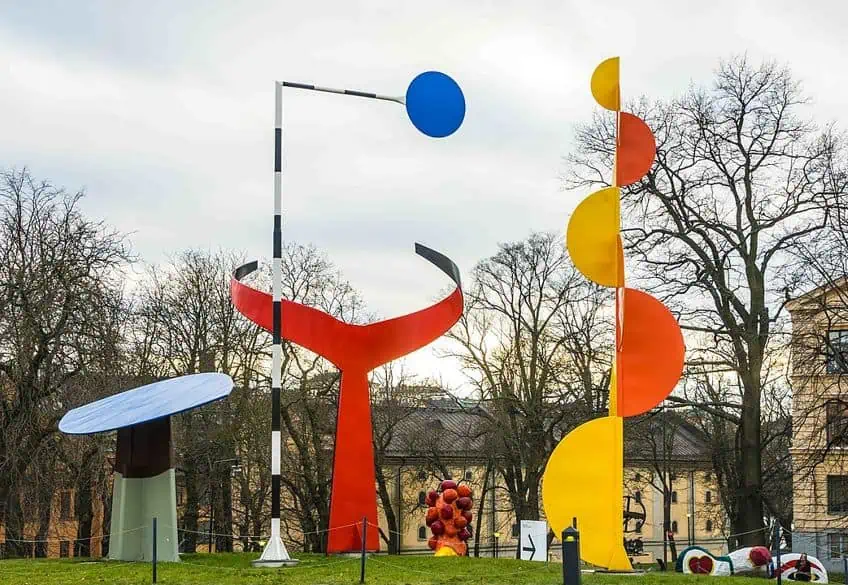
Calder was always fascinated by the circus, and in 1926, after moving to Paris, he began to create what would become Cirque Calder, an intricate and unique work of art. This one-of-a-kind assembly included small-scale actors, animals, and sets that he had studied closely while working at the circus. Cirque Calder was made with wire, leather, cloth, and other found objects. Calder designed for the work to be manually manipulated. All the parts were sufficiently small to fit neatly into a big trunk, which made it possible for Calder to take it with him everywhere he went and use it in a variety of environments, like staging performances for his friends. Later, Calder carried on with his circus performances in Paris and New York. These elaborately detailed performances of Calder’s circus usually lasted two hours or more.
Mature Period
Alexander Calder’s art began shifting from representational oil paintings in the late 1920s towards more experimental work. But in 1930, a trip to Piet Mondrian’s studio proved the true turning point, as Calder permanently switched from figurative to abstract painting. Calder was drawn in by the colorful rectangles that covered one wall of Mondrian’s studio. Calder recalled wanting to move and oscillate the squares, a notion Mondrian was not taken by. Calder, however, left the visit feeling inspired.
With new motivation, Calder decided to become a member of the prominent Abstraction-Creation group, which concentrated on the goal of giving abstract color a sense of movement in space.
Less than a year after joining, Calder debuted his first abstract wire sculptures, which helped to pioneer kinetic art. With this, Calder became one of the first contemporary American wire sculpture artists. The term “mobiles” was first used by Marcel Duchamp to refer to these pieces; it was later expanded to include Calder’s later works that used air currents rather than motors to move.
Calder also experimented with creating static sculptures in the 1930s, which Hans Arp called “stabiles.” Like the mobiles, Calder’s stabiles openly included bolts and fastening flanges as essential design elements despite being made of visible construction materials. Even in their stable footing, the sculptures evoke a sense of freedom and movement. In 1933, Calder moved to Connecticut in search of more space for larger hanging pieces and outdoor sculptures. In parallel, Calder started working with dancer Martha Graham and composer Erik Satie to create sets and costumes for theater plays. This was a creative endeavor he continued throughout his career. Calder carried on holding Calder’s Circus performances into the late 1930s. Before going back to the United States in 1938, he traveled throughout Europe holding exhibitions and finishing commissions. Calder was commissioned by The Museum of Modern Art in 1939 to build the massive mobile known as Lobster Trap and Fish Tail.
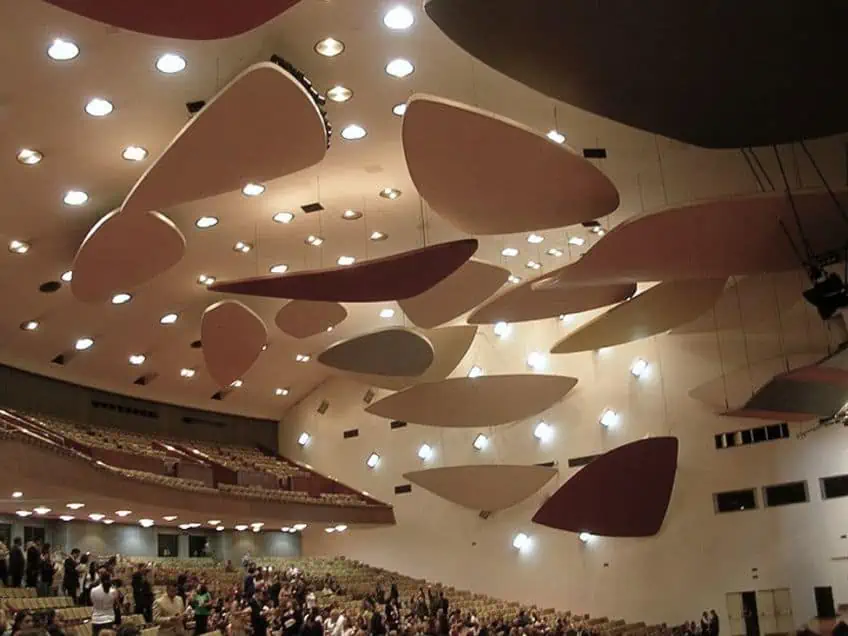
Calder painted a great deal of colorful gouache pictures during World War II. In his sculptures, he mainly used wood rather than metal because of a lack of available materials. He produced Constellations, a collection of light, three-dimensional stabiles made of carved wooden shapes and wire. In 1943, Calder was honored with a retrospective exhibition at the Museum of Modern Art in New York. Another important exhibition of Calder’s artwork was held in 1946 at the Galerie Louis Carre in Paris. This show was accompanied by a historic catalog essay penned by Jean-Paul Sartre.
Late Period
Working from an enormous studio he built in Roxbury, Connecticut, Calder created several monumental public sculptures in the 1960s and 1970s, frequently with his family present. He created some mobiles among these, but his outdoor pieces were more often large-scale stabiles. UNESCO in Paris in 1958, the New York Port Authority in 1957, and the National Endowment for the Arts in 1969 were just a few of the many international commissions he received during this time. Calder traveled and worked in many places across the world with his family, including France, Ahmedabad, India, Beirut, Lebanon, London, and New York. He carried on making jewelry, setting designs, and smaller sculptures at the same time.
He even started designing tapestries in 1960. In 1962, Calder built his largest studio in Sache, France, near the home of his friend Jean Davidson.
Five Alexander Calder Facts
Alexander Calder’s legacy extends far beyond his innovative artistic creations; it encompasses a rich tapestry of intriguing anecdotes, artistic ingenuity, and a passionate commitment to the causes he believed in. Below, we explore five interesting Alexander Calder facts, ranging from his creative innovations to his political activism.

The Origin of ‘Drawing in Space’
The term ‘drawing in space’ is often associated with Calder’s wire sculptures. While it is commonly attributed to artist Julio González, writing about Pablo Picasso’s iron sculptures in 1932, the term was first used in reference to Alexander Calder’s work in 1929. During one of Calder’s solo exhibitions held at Galerie Billiet-Pierre Vorms in Paris, an art critic from the French newspaper Paris-Midi described Calder’s wire sculptures as ‘drawings in space.’
The term gained further prominence when Paul Fierens, writing in the newspaper Journal des Débats, used it to characterize Calder’s innovative wire sculptures.
The Invention of the Mobile
The creation of the mobile is among the most famous of Alexander Calder’s art. Calder’s artistic direction changed dramatically from figurative to abstract sculpture in 1930. He imagined the idea of putting these abstract pieces into motion, having been inspired by them. He realized this vision in 1931 when he made his first mobile, a motor-driven tabletop sculpture. The French word “mobile,” which means “motion” and “motive,” was created by none other than Marcel Duchamp. This signaled the advent of mobiles as we know them today—items propelled by air currents that move on their own.

A Record-Breaking Retrospective
In 1943, Alexander Calder achieved a remarkable milestone by becoming the youngest artist ever to receive a retrospective of his work at the prestigious Museum of Modern Art (MoMA) in New York. The exhibition “Alexander Calder: Sculptures and Constructions” honored Calder’s career at the young age of forty-five.
Marcel Duchamp and James Johnson Sweeney organized the exhibition, which was so well-received that it was extended for almost two months after it was scheduled to end.
The Mystery of His Birthdate
Even now, it’s unknown exactly when Alexander Calder was born. He was born in the Pennsylvanian suburb of Lawnton, and his family thought he was born on August 22, 1898. But when 44-year-old Calder went to Philadelphia City Hall to get a copy of his birth certificate, he found that the date of birth was listed as July 22, 1898. He tried to have this discrepancy challenged, but his parents, sister, and mother insisted that August was the true birth month.
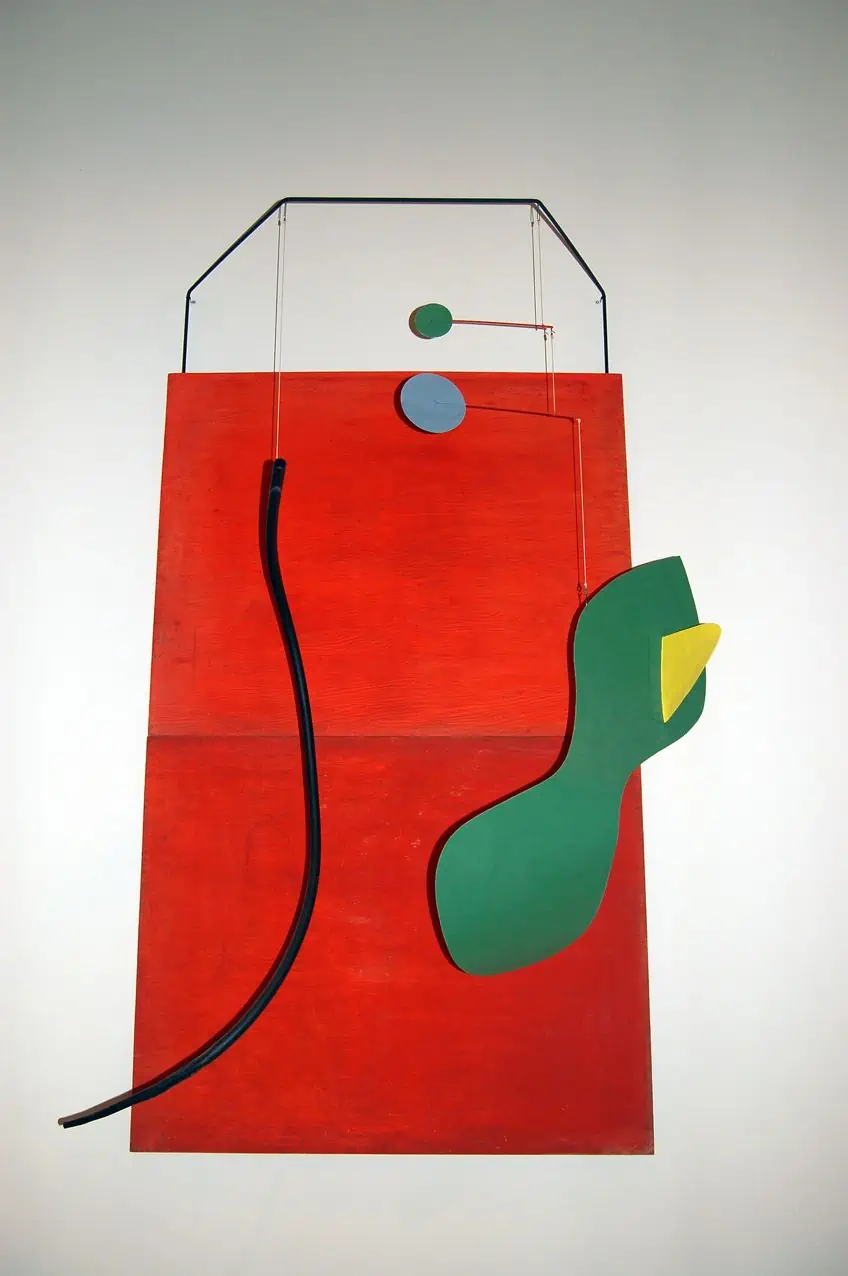
A Politically Aware Artist
Calder was politically active and conscious in addition to his artistic endeavors. He actively supported friends who were artists who were stuck in war-torn Europe during World War II. To facilitate their entry into America, he corresponded with the US government. In addition, Calder conducted art workshops in military hospitals while assisting injured and traumatized soldiers. Later in life, he and his wife Louisa took a strong stand against the Vietnam War.
They organized marches and, on January 2, 1966, published a full-page ad in The New York Times bearing the slogan “Reason is not treason”.
Five Seminal Alexander Calder Artworks
Alexander Calder, an artist known for his groundbreaking contributions to the world of art, left an indelible mark on the art landscape with his imaginative and innovative creations. Below, we explore five of his most important artworks, each bearing its distinct significance and artistic brilliance.
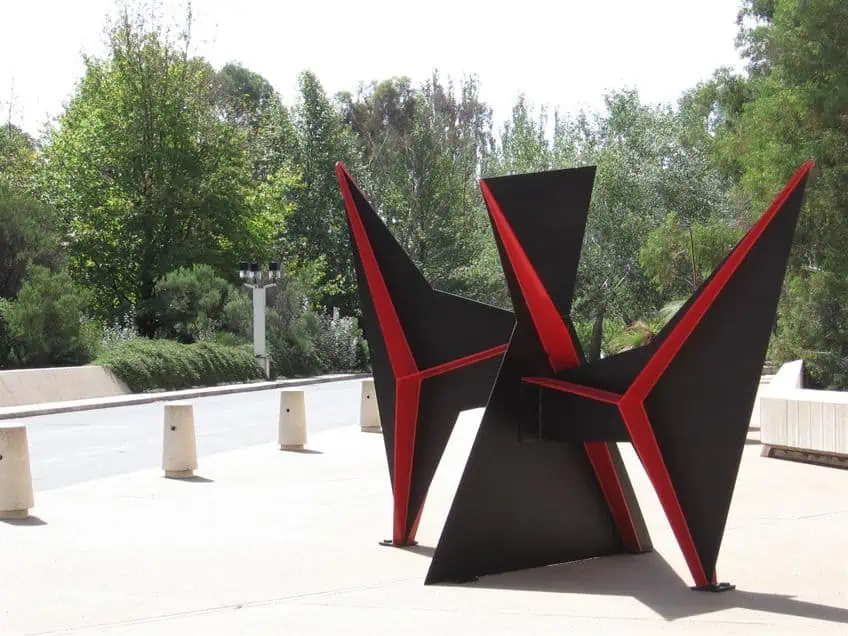
Cirque Calder (1926 – 1931)
| Date | 1926 – 1931 |
| Medium | Wire, fabric, leather, rubber, cork, and other materials |
| Size (cm) | 137.2 × 239.4 × 239.4 |
| Collection | Whitney Museum of American Art, New York City, United States |
Alexander Calder’s fascination with the circus in his twenties inspired him to create Cirque Calder, an enthralling miniature world of wonder. His fascination with the circus, particularly its large interior, served as the inspiration for this original work of art. After being first crammed into just two suitcases, Cirque Calder changed over time, drawing crowds, and gaining the artist’s notoriety in a unique way. A world of imagination was brought to life in this miniature circus by the creatively articulated figures, animals, and props used in its populace. Cirque Calder was a major early success in Calder’s career and a precursor to the kinetic art that would define his later works.
Calder’s performances, narrated in English or French and accompanied by music and lighting, mesmerized audiences.

Josephine Baker III (1927)
| Date | 1927 |
| Medium | Steel wire |
| Size (cm) | 99 x 56.6 x 24.5 |
| Collection | Museum of Modern Art, New York City, United States |
This early Alexander Calder artwork showcases his love of using wire as a medium. In this work, Calder gives homage to the legendary Josephine Baker, one of the most well-known performers of her era. Calder’s unique works in wire, which he described as something that “moves of its own volition” and “jokes and teases,” delighted the public and attained him the title of “The King of Wire” among Parisian critics.
The vibrant wire sculpture Josephine Baker III, which reflects Calder’s fascination with the flexibility of wire and its ability to evoke a sense of energy and movement, perfectly captures the essence of the performer’s exuberance and motion.
Mercury Fountain (1937)
| Date | 1937 |
| Medium | Sheet metal, rod, wire, pitch, paint, and mercury, with pumping mechanism and basin |
| Size | 61,3 meters high |
| Collection | Fundació Joan Miró, Barcelona, Spain |
The Mercury Fountain was designed by Calder for his participation in the 1937 Paris World’s Fair. Calder’s fountain featured a rod with a red disc at one end and the word “ALMADEN” written in wire hanging from the other, along with a series of asymmetrically shaped steel plates for the mercury to flow over. Viewers were treated to an entertaining show as the mercury oscillated as it passed through the fountain and caused the rod to move. When the Mercury Fountain was first exhibited with Picasso’s Guernica, it offered visitors a singular and unforgettable experience by inviting them to toss coins onto the mercury’s surface and watch them float.
However, the artwork is currently on display behind glass at Barcelona’s Fundació Joan Miró because of its extreme toxicity.

Arc of Petals (1941)
| Date | 1941 |
| Medium | Painted and unpainted sheet aluminum and iron wire |
| Size (cm) | 240 x 220 x 90 cm |
| Collection | Peggy Guggenheim Collection, Venice, Italy |
Calder’s fascination with motion and balance led to the creation of his mobiles. One of these captivating pieces, Arc of Petals, showcases the artist’s commitment to exploring the interplay of shape, size, color, space, and movement. Composed of painted and unpainted sheet aluminum and iron wire, this mobile presents a cascade of antigravitational elements. Large, mature shapes serenely sway at the top, while small, agitated, undifferentiated forms dip and rock below. Calder’s ability to craft dynamic relationships among the components of his mobiles made them captivating expressions of natural form and kinetic art.
In this work, Calder deliberately chose to leave one leaf unpainted, exposing the aluminum surface, emphasizing the significance of variety and the artist’s intervention in achieving the artwork’s overall success.
La Grande Vitesse (1969)
| Date | 1969 |
| Medium | Sheet metal, bolts, and paint |
| Size (m) | 13 x 16.5 x 9 |
| Collection | The City of Grand Rapids, Michigan, United States |
In 1969, Calder’s monumental public artwork, La Grande Vitesse, was installed in the plaza outside City Hall in Grand Rapids, Michigan. The title, humorously translating to “Great Speed” in French, became synonymous with the city’s identity. However, the artwork was not without controversy, sparking debates among locals about its inclusion in the public space. Despite the initial divide, La Grande Vitesse, and Calder Plaza, as it is now known, has become an integral part of the city’s cultural identity.
This Alexander Calder artwork, a monumental stabile, stands as a testament to the artist’s ability to infuse creativity into public spaces, leaving a lasting impact on the community.
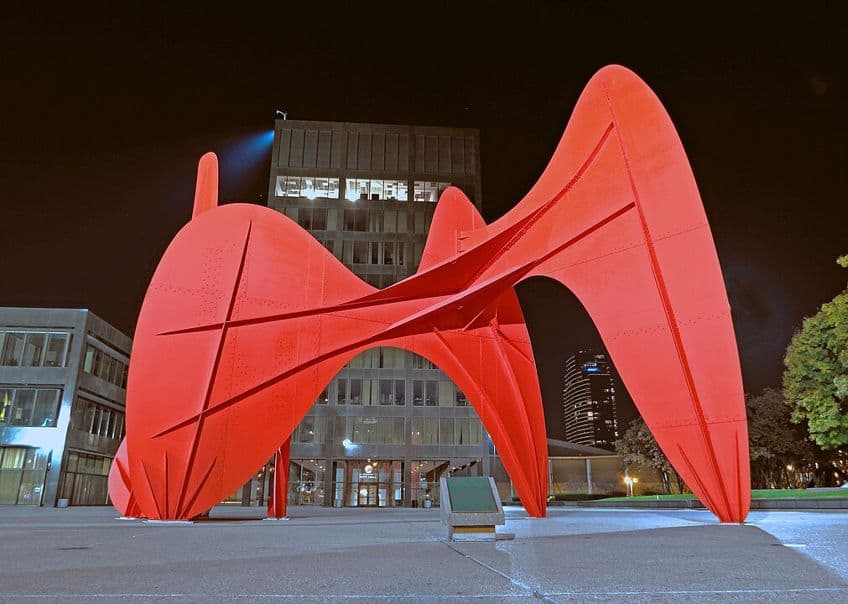
Reading Recommendations
Alexander Calder, a pioneering artist known for his innovative approach to sculpture and kinetic art, has left an indelible mark on the art world. If you’re captivated by his work and artistic journey, consider diving into these books that offer valuable insights into the life and creations of this remarkable artist.
These three books capture the essence of Calder’s career in an easy-to-understand format.
Calder (1999) by Jacob Baal-Teshuva
In 1999, Jacob Baal-Teshuva’s book offered an initial exploration of Alexander Calder’s life and artistry. It delved into Calder’s unique journey, covering his cultural and historical significance. This publication provided a detailed chronological summary of the artist’s life, including a concise biography. With approximately 100 color illustrations complemented by explanatory captions, readers were introduced to the early phases of Calder’s artistic career.

- An in-depth exploration of Calder's life and artistry
- Explore the cultural and historical significance of his work
- A chronological summary of Calder's career
Alexander Calder: From Stony River to the Sky (2018) by Alexander Calder, Susan Braeuer Dam, and Jessica Holmes
The year 2018 marked the release of a catalog that vividly illustrated an ambitious exhibition featuring Alexander Calder’s works. This exhibition displayed over 90 pieces by Calder, ranging from paintings and mobiles to stabiles, jewelry, domestic objects, and monumental outdoor sculptures. The book also explored Calder’s life and creative practice, drawing parallels between his work in the British countryside and his longtime home and studio in Roxbury, Connecticut.
It included insightful essays by Jessica Holmes and Susan Braeuer Dam, shedding light on Calder’s artistic evolution.
- A catalog exhibiting the work of Alexander Calder
- Explore a collection of paintings, mobiles, jewelry, and more
- Take a closer look at Calder's creative process
Alexander Calder: Modern from the Start (2021) edited by Cara Manes
This book celebrates the enduring relationship between Alexander Calder and the Museum of Modern Art (MoMA). Through MoMA’s recognition of Calder as a pioneer of modern sculpture, and Calder’s substantial gift of 19 works in 1966, the artist played a pivotal role in shaping the identity of MoMA as an American museum of modern art. This book offered a contemporary perspective on Calder’s lifelong impact on the art world.
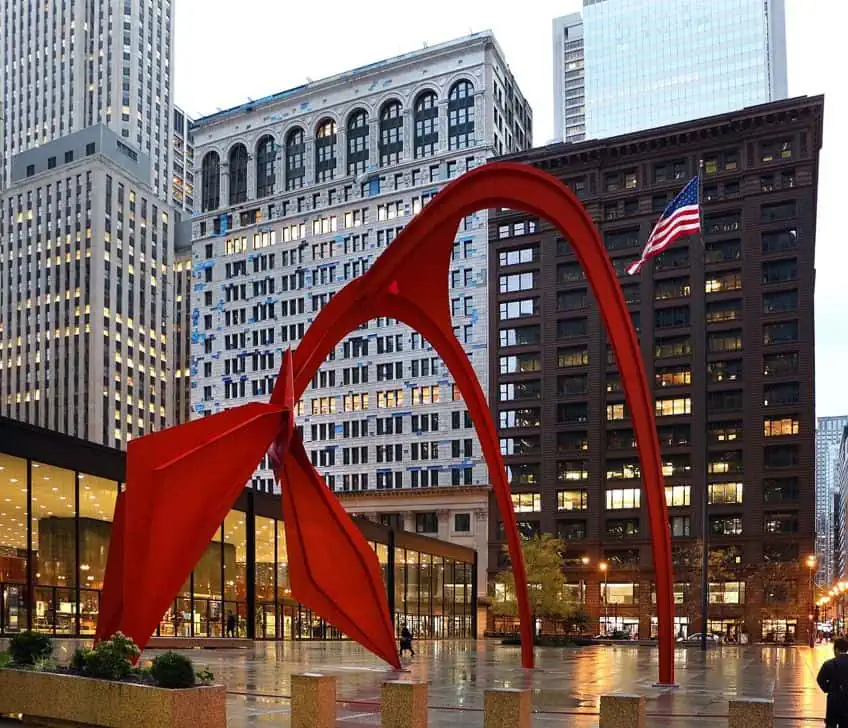
- Explore the relationship between Calder and MoMa
- A contemporary perspective on Calder's lifelong impact
- Discover many of Calder's famous works in MoMa
Alexander Calder’s innovative approach to sculpture and kinetic art challenged conventional boundaries, introducing a new dimension of movement and whimsy to the art world. Calder’s pioneering mobiles and artistic ingenuity have not only left an indelible mark on the art landscape, but also continue to inspire generations of artists and captivate art enthusiasts. His ability to transcend artistic norms and explore the dynamic relationship between form and movement remains a testament to his enduring importance in the realm of contemporary art.
Frequently Asked Questions
Was Alexander Calder Always an Artist?
Alexander Calder always had a passion for creating art. However, in his early twenties, he pursued a formal education in mechanical engineering at the Stevens Institute of Technology in New Jersey, the United States. It’s interesting to note that he chose this field rather arbitrarily, influenced by a friend’s choice of study. Nevertheless, Calder’s strong aptitude for mathematics during his engineering education later played a crucial role in shaping his unique and ingenious approach to art. He began seriously exploring painting a few years after earning his engineering degree.
What Is Alexander Calder Most Renowned For?
Alexander Calder is known as one of the most famous wire sculpture artists. While Calder was not the first artist to experiment with metal and movement in his work, he gained widespread recognition for pioneering these elements. His most famous creations are what Marcel Duchamp referred to as mobiles. Calder’s mobiles were characterized by their graceful and whimsical movements, often defying the conventional use of a fixed base or pedestal to anchor sculptures to the ground.
How Did He Transport Some of His Artworks?
Calder developed an innovative method of disassembling even his large sculptures for unobtrusive transportation, effectively creating what can be described as flat pack artworks. To ensure a smooth reassembly process at the destination and avoid customs complications, he meticulously provided detailed, numbered, and color-coded instructions along with each piece. This approach allowed his artworks to be transported and reconstructed with precision, preserving the integrity of his creations.
Jordan Anthony is a Cape Town-based film photographer, curator, and arts writer. She holds a Bachelor of Art in Fine Arts from the University of the Witwatersrand, Johannesburg, where she explored themes like healing, identity, dreams, and intuitive creation in her Contemporary art practice. Jordan has collaborated with various local art institutions, including the KZNSA Gallery in Durban, the Turbine Art Fair, and the Wits Art Museum. Her photography focuses on abstract color manipulations, portraiture, candid shots, and urban landscapes. She’s intrigued by philosophy, memory, and esotericism, drawing inspiration from Surrealism, Fluxus, and ancient civilizations, as well as childhood influences and found objects. Jordan is working for artfilemagazine since 2022 and writes blog posts about art history and photography.
Learn more about Jordan Anthony and about us.
Cite this Article
Jordan, Anthony, “Alexander Calder – Introducing the Kinetic Mobile Artist.” artfilemagazine – Your Online Art Source. February 5, 2024. URL: https://artfilemagazine.com/alexander-calder/
Anthony, J. (2024, 5 February). Alexander Calder – Introducing the Kinetic Mobile Artist. artfilemagazine – Your Online Art Source. https://artfilemagazine.com/alexander-calder/
Anthony, Jordan. “Alexander Calder – Introducing the Kinetic Mobile Artist.” artfilemagazine – Your Online Art Source, February 5, 2024. https://artfilemagazine.com/alexander-calder/.






